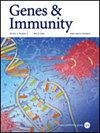利用大数据生存信息统一多发性骨髓瘤风险分级相关的适应性免疫受体参数
IF 4.5
3区 医学
Q1 GENETICS & HEREDITY
引用次数: 0
摘要
随着治疗方案的改进,多发性骨髓瘤患者的预期寿命有所延长,但这种疾病在很大程度上仍然无法治愈。免疫疗法是一个不断发展的领域,它显示了治疗进步的希望,最近的研究表明,利用免疫受体、互补性决定区-3(CDR3)-候选抗原化学互补性评分来识别亚组患者的生存差异是一个机会。在这里,我们应用互补性评分算法来确定与多发性骨髓瘤相关的、与生存差异相关的 CDR3-癌睾丸抗原(CTA)关系。此外,我们还将这些免疫受体特征与之前的一项研究进行了重叠,该研究显示,基于 T 细胞受体、V 基因和 J 基因片段的使用、HLA 等位基因组合,患者的存活率有显著差异,在某些组合组中,100% 的患者在研究期间没有因多发性骨髓瘤而死亡。这种重叠评估与以下观点一致:TRB-抗原-HLA 组合在生产上可能会受到相当大的限制,但 TRA-抗原-HLA 组合则具有更大的灵活性和不可预测性。此外,本报告中的方法还表明了 CTA IGSF11 作为多发性骨髓瘤抗原的潜在重要性。本文章由计算机程序翻译,如有差异,请以英文原文为准。


Exploiting big data survival information to unify risk-stratification related, adaptive immune receptor parameters for multiple myeloma
With the improvement of treatment options, multiple myeloma related life expectancy has been prolonged, but the disease remains largely incurable. Immunotherapy is a growing field that shows promise in advancements for treatment, and recent work has demonstrated an opportunity to use immune receptor, complementarity determining region-3 (CDR3)-candidate antigen chemical complementarity scores to identify survival distinctions among subgroups of patients. Here, we have applied the complementarity scoring algorithm to identify multiple myeloma related, CDR3-cancer testis antigen (CTA) relationships associated with survival distinctions. Furthermore, we have overlapped these immune receptor features with a previous study that showed a dramatic survival distinction based on T-cell receptor, V- and J-gene segment usage, HLA allele combinations, whereby 100% of the patients in certain combination groups had no mortality related to multiple myeloma, during the study period. This overlap evaluation was consistent with the idea that there are likely considerable constraints on productive TRB-antigen-HLA combinations but more flexibility, and unpredictability, for the TRA-antigen-HLA combinations. Also, the approaches in this reported indicated the potential importance of the CTA, IGSF11, as a multiple myeloma antigen, an antigen previously, independently considered as a vaccine candidate in other settings.
求助全文
通过发布文献求助,成功后即可免费获取论文全文。
去求助
来源期刊

Genes and immunity
医学-免疫学
CiteScore
8.90
自引率
4.00%
发文量
28
审稿时长
6-12 weeks
期刊介绍:
Genes & Immunity emphasizes studies investigating how genetic, genomic and functional variations affect immune cells and the immune system, and associated processes in the regulation of health and disease. It further highlights articles on the transcriptional and posttranslational control of gene products involved in signaling pathways regulating immune cells, and protective and destructive immune responses.
 求助内容:
求助内容: 应助结果提醒方式:
应助结果提醒方式:


